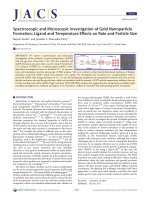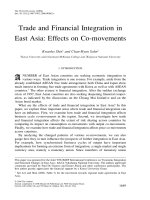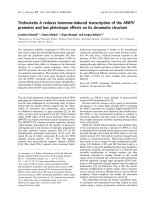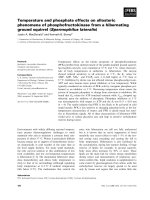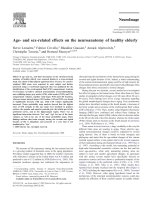Accommodation effects on peripheral ocular biometry
Bạn đang xem bản rút gọn của tài liệu. Xem và tải ngay bản đầy đủ của tài liệu tại đây (2.43 MB, 230 trang )
ACCOMMODATION EFFECTS ON
PERIPHERAL OCULAR BIOMETRY
Hussain Mubarak D Aldossari
BSc (Optom), MSc (Optom)
Submitted in fulfilment of the requirements for the degree of
Doctor of Philosophy
School of Optometry and Vision Science
Institute Of Health and Biomedical Innovation
Faculty of Health
Queensland University of Technology
Brisbane, Qld, Australia
2016
ii
Keywords
Axial length
Accommodation
Biometry
Choroidal thickness
Emmetropia
IOLMaster
Lenstar
Myopia
Partial coherence interferometry
Peripheral eye length
Refractive error
Retina
Spectral domain optical coherence tomographer
iii
Abstract
There is a well-known association between near work and myopia development.
During myopia development, the axial length of eye increases and the choroid thins
at the fovea. Traditionally the fovea was thought to drive myopia development, but
the peripheral retina is now known to be important to refractive development.
Accommodation may alter the peripheral ocular biometry. This project determined
the impact of accommodation on the biometric properties of axial length and
choroidal thickness along the horizontal visual field in emmetropic and myopic eyes.
In Experiment 1 (chapter 4), the effect of accommodation on peripheral axial
length was measured in 83 young adults (29 emmetropes, 32 low myopes and 22
high myopes) using a modified Lenstar LS 900 partial coherence interferometer
along the horizontal visual field out to ±30° for both 0 D and 6 D accommodation
demands. There were significant increases in axial lengths with accommodation at all
eccentricities. Axial length changes were significantly greater for higher myopes than
for emmetropes on-axis (higher myopes 41 ± 29 µm, emmetropes 30 ± 22 µm, p =
0.005), for higher myopes than for low myopes at 30° nasal (p = 0.03), and for higher
myopes than for the other groups at 20° nasal (p < 0.05). At all positions, there were
significant negative correlations between changes in axial length along the horizontal
meridian and spherical equivalent refraction of myopic eyes.
In Experiment 2 (chapter 5), peripheral axial length was monitored during
eight min of accommodation to a 6 D stimulus and then during eight min of
recovery. There were 23 emmetropic and 28 myopic adults, and measurements were
taken at 0°, 20° nasal and 20° temporal visual field positions. There were sustained
iv
axial length elongations during the entire accommodation task. Elongations were
greater for the myopes than for the emmetropes. The post-task recovery was slower
and was still incomplete after 8 min. The recovery was similar for emmetropes and
myopes in terms of percentage of the maximum elongations at all positions.
In Experiment 3 (chapter 6), choroidal thickness changes with accommodation
were investigated in 69 young adults (24 emmetropes, 23 low myopes and 22 higher
myopes). Choroidal thickness was measured with an optical coherence tomographer
along the horizontal visual field out to ±35° for both 0 D and 6 D accommodation
demands. For both demands, refractive group affected choroidal thickness
significantly at most angles. For the 22 out of 28 accommodation/visual field
combinations at which significance occurred, emmetropes and low myopes had
significantly thicker choroids than higher myopes for 21 and 11 combinations,
respectively. Choroids thinned with accommodation, with the thinning lessening
away from the fovea. At the fovea, the thinning was affected significantly by
refractive group where the higher myopes thinned more than the emmetropes (mean
± SE: 9.0 ± 2.4 m), and at 30° temporal where the emmetropes thinned more than
low myopes (4.6 ± 1.8 µm) and
higher myopes (7.1 ± 1.9 m). There were
significant negative correlations between accommodation-induced changes in
choroidal thickness and axial eye length for all refractive groups at all positions. The
choroidal thickness changes were responsible for most of the axial length changes.
In conclusion, this project has found differences between refractive groups in their
ocular biometry responses to accommodation across the horizontal visual field.
These differences suggest a potential mechanism by which near work may alter axial
length and choroidal thickness and thus lead to the development of myopia.
v
Table of Contents
Keywords…................................................................................................................ iii
Abstract…… .............................................................................................................. iv
Table of Contents ...................................................................................................... vi
List of Figures ............................................................................................................. x
List of Tables............................................................................................................ xiii
List of Abbreviations ................................................................................................ xv
Statement of Original Authorship ........................................................................ xvii
Acknowledgements ................................................................................................ xviii
CHAPTER 1: INTRODUCTION ............................................................................. 1
1.1 Introduction .......................................................................................................... 1
1.2 Scope of the thesis ................................................................................................. 5
CHAPTER 2: LITERATURE REVIEW ................................................................. 6
2.1 Background on myopia .................................................................................... 6
2.1.1 Definition and classification of myopia ...................................................... 6
2.1.2 Prevalence of myopia .................................................................................. 7
2.1.3 Socioeconomic cost of myopia ................................................................. 10
2.2 Aetiology of myopia ............................................................................................ 11
2.2.1 Genetic factors........................................................................................... 11
2.2.2 Environmental factors ............................................................................... 12
2.3 Other risk factors ............................................................................................... 14
2.3.1 Intraocular pressure ................................................................................... 14
2.3.2 Ocular aberrations ..................................................................................... 15
2.3.3 Force of extra-ocular muscles ................................................................... 16
2.4 Biometry of the myopic eye ............................................................................... 17
vi
2.4.1 Axial length measurement techniques ...................................................... 17
2.4.2 Anterior chamber depth ............................................................................ 18
2.4.3 Myopia and axial length ............................................................................ 18
2.4.4 Retinal thickness ....................................................................................... 19
2.4.5 Choroidal thickness ................................................................................... 20
2.5 Accommodation .................................................................................................. 23
2.5.1 Tonic accommodation ............................................................................... 24
2.5.2 Accommodation response ......................................................................... 25
2.5.3 Near work-induced transient myopia (NITM) .......................................... 29
2.6 Impact of accommodation on biometry ........................................................... 32
2.6.1 Axial length ............................................................................................... 32
2.6.2 Biometry of the anterior segment.............................................................. 35
2.7 Eye shape models ............................................................................................... 35
2.7.1 Eye shape measurement ............................................................................ 37
2.8 Peripheral retina ................................................................................................ 38
2.8.1 Accommodation and peripheral retina ...................................................... 38
2.8.2 Peripheral defocus: animal studies ............................................................ 39
2.8.3 Eye shape and peripheral refraction .......................................................... 40
2.8.4 Impact of accommodation on peripheral refraction .................................. 42
2.9 Measurement issues ........................................................................................... 44
2.9.1 Effect of phenylephrine on accommodation ............................................. 44
2.10 Rationale of the study ...................................................................................... 45
CHAPTER 3: METHODOLOGY .......................................................................... 48
3.1 Ethical considerations ........................................................................................ 48
3.2 Recruitment of participants and screening ..................................................... 48
3.3 Accommodation measurement with the COAS aberrometer ........................ 49
3.4 Peripheral axial length measurement with Lenstar LS 900 ........................... 54
3.4.1 Effect of the beamsplitter on Lenstar measurements ................................ 59
3.4.2 Repeatability of on-axis and peripheral eye length measurements ........... 60
3.4.3 Correction factors ...................................................................................... 63
3.5 Peripheral choroidal thickness measurement with Nidek RS-3000 .............. 68
3.6 Data analysis - Experiments 1, 2 and 3 ............................................................ 74
vii
CHAPTER 4: THE EFFECT OF ACCOMMODATION ON PERIPHERAL
EYE LENGTHS OF EMMETROPES AND MYOPES ....................................... 77
Abstract ..................................................................................................................... 77
4.1. Introduction ....................................................................................................... 79
4.2. Materials and methods...................................................................................... 81
4.2.1 Participants ................................................................................................ 82
4.2.2 Procedure................................................................................................... 84
4.2.3 Analysis ..................................................................................................... 85
4.3. Results ................................................................................................................ 87
4.4 Discussion ............................................................................................................ 98
4.5 Conclusion ......................................................................................................... 101
CHAPTER 5: CHANGE IN PERIPHERAL EYE LENGTH DURING AN
EXTENDED PERIOD OF ACCOMMODATION IN EMMETROPES AND
MYOPES…. ............................................................................................................ 102
Abstract ................................................................................................................... 102
5.1. Introduction ..................................................................................................... 104
5.2 Materials and methods..................................................................................... 107
5.2.1 Participants .............................................................................................. 107
5.2.2 Procedure................................................................................................. 109
5.3 Data analysis ..................................................................................................... 110
5.4 Results ............................................................................................................... 111
5.5 Discussion .......................................................................................................... 118
5.6 Conclusion ......................................................................................................... 122
CHAPTER 6: PERIPHERAL CHOROIDAL THICKNESS CHANGES
WITH ACCOMMODATION IN EMMETROPIC AND MYOPIC EYES ..... 123
viii
Abstract ................................................................................................................... 123
6.1 Introduction ...................................................................................................... 125
6.2 Materials and methods .................................................................................... 127
6.2.1 Choroidal thickness measurement – OCT image acquisition ................. 127
6.2.2 Participants .............................................................................................. 129
6.3 Data analysis ..................................................................................................... 130
6.4 Results ............................................................................................................... 130
6.5 Discussion .......................................................................................................... 146
6.6 Conclusions ....................................................................................................... 152
CHAPTER 7: DISCUSSION AND CONCLUSION........................................... 153
7.1 Summary of findings ........................................................................................ 153
7.2 The effect of accommodation on the peripheral axial length of the eye ...... 154
7.3 Time dynamics of the effect of accommodation on the peripheral axial
length of the eye ...................................................................................................... 156
7.4 The effect of accommodation on the peripheral choroidal thickness of
the eye…. ................................................................................................................. 157
7.5 Role of choroid in axial elongation ................................................................. 159
7.6 Other mechanisms which might be causing axial elongation ...................... 160
7.7 Clinical relevance ............................................................................................. 163
7.8 Future work ...................................................................................................... 164
References ............................................................................................................... 166
Appendix 1 - Ethics approval forms ..................................................................... 205
Appendix 2 - Conference presentation ................................................................. 211
ix
List of Figures
Figure 2.1: Definition of emmetropia and myopia. ........................................................... 6
Figure 2.2: The anterior lens curvature and lens thickness increase during
accommodation, ...................................................................................................... 23
Figure 2.3: Models of retinal stretching in myopia. ........................................................ 36
Figure 2.4: Scanning sections and axis of the eye,.......................................................... 37
Figure 3.1: The Hartmann-Shack Aberrometer............................................................... 51
Figure 3.2: Experimental setup using external attachment with the COAS-HD to
measure accommodative response. ......................................................................... 53
Figure 3.3: Alignment of the eye using the COAS-HD. ................................................. 53
Figure 3.4: Principle of partial coherence interferometry ............................................... 55
Figure 3.5: Experiment 1 setup with external attachment to measure on-axis and
peripheral axial length. ............................................................................................ 58
Figure 3.6: Flow chart of the procedure used to measure the time course of peripheral
axial elongation during and following an extended period of accommodation. ..... 59
Figure 3.7: Bland-Altman axial length difference versus mean plots with 0 D of
accommodation stimulus. ........................................................................................ 62
Figure 3.8: Bland-Altman axial length difference versus mean plots with 6 D of
accommodation stimulus. ........................................................................................ 63
x
Figure 3.9: Schematic of SD-OCT system...................................................................... 69
Figure 3.10: (A) OCT to measure on-axis and peripheral choroidal thickness. (B) The
participant was instructed to focus on a red cross symbol for all positions along
the horizontal meridian. .......................................................................................... 71
Figure 3.11: Schematic diagram of experimental setup to measure the choroidal
thickness .................................................................................................................. 72
Figure 3.12: The dialog box of eyeball optics correction. .............................................. 73
Figure 3.13: Raw OCT view of (A) nasal, (B) central and (C) temporal choroid
obtained using the Nidek OCT................................................................................ 74
Figure 4.1: Axial length of eye (AL) for 0 D and 6 D accommodation stimuli along
the horizontal meridian ........................................................................................... 92
Figure 4.2: The mean changes in axial length (∆AL) with accommodation along the
horizontal meridian ................................................................................................. 93
Figure 4.3: Frequency histograms of change in axial length (Δ AL) in emmetropes,
low myopes and higher myopes at (A) on-axis, (B) 20° nasal, and (C) 30° nasal
field. ........................................................................................................................ 94
Figure 4.4: Correlation between the accommodation-induced change in axial length
(∆AL) and (A) spherical equivalent refraction along the optical axis .................... 95
Figure 5.1: Mean change in axial length (∆AL) over time from the baseline at 6 D
and 0 D accommodation demand for emmetropes and myopes ........................... 113
Figure: 5.2: The recovery of axial length (AL) to baseline by percentage over time ... 114
Figure 5.3: Correlation between spherical equivalent refraction and changes in axial
length ..................................................................................................................... 115
xi
Figure 5.4: Correlation between baseline axial length (at 0s) and spherical equivalent
refraction ............................................................................................................... 116
Figure 5.5: Correlation between baseline axial length and spherical equivalent
refraction ............................................................................................................... 117
Figure 6.1: Choroidal thickness for 0 D and 6 D accommodation stimuli as a function
of visual field angle ............................................................................................... 138
Figure 6.2: The mean changes in axial length (∆AL) and choroidal thickness (∆ChT)
with accommodation along the horizontal meridian ............................................. 139
Figure 6.3: Relationship between accommodation-induced changes in axial length
(∆AL) and changes in choroidal thickness (∆ChT) in (A) emmetropes, (B) low
myopes and (C) higher myopes on-axis. ............................................................... 141
Figure 6.4: Relationship between accommodation-induced changes in axial length
(∆AL) and choroidal thickness (∆ChT) in (A) emmetropes, (B) low myopes and
(C) higher myopes at 20° nasal field. .................................................................... 142
Figure 6.5: Relationship between accommodation-induced changes in axial length
(∆AL) and choroidal thickness (∆ChT) in (A) emmetropes, (B) low myopes and
(C) higher myopes at 20° temporal field. .............................................................. 143
Figure 6.6: Correlation between the accommodation-induced change choroidal
thickness (∆ChT) and spherical equivalent refraction on-axis in (A) emmetropes
(n = 24) and (B) all myopes (n = 45). ................................................................... 144
Figure 7.1: Model of changes in accommodated eye (not to scale). During
accommodation the lens thickness changes and the choroid thins which leads to
axial elongation. .................................................................................................... 162
xii
List of Tables
Table 2.1: Myopia prevalence for adults in different countries. ....................................... 9
Table 2.2: Myopia prevalence in children in different countries. ................................... 10
Table 2.3: Choroidal thickness of healthy participants on-axis. ..................................... 22
Table 2.4: Impact of the refractive error type on the accommodation response
stimulus function (ASR). ........................................................................................ 27
Table 2.5: Near work-induced transient myopia (NITM) under closed loop
conditions. ............................................................................................................... 30
Table 2.6: Accommodation adaptation as a function of refractive error (open loop
conditions). .............................................................................................................. 31
Table 3.1: Mean (± SD) for Lenstar measurement with and without a beam splitter. .... 60
Table 3.2: Gullstrand model No. 1 (exact) without accommodation. ............................. 66
Table 3.3: Gullstrand model No. 1 (exact) with accommodation (10.88 D). ................. 67
Table 3.4: Errors in Lenstar measurement due to accommodation (µm)........................ 67
Table 4.1: Group characteristics ..................................................................................... 83
Table 4.2: Axial lengths (mm) in the unaccommodated and accommodated states
along the horizontal field meridian for the three refractive groups. ....................... 90
Table 4.3: Changes in axial length (µm) with accommodation for the refractive error
groups. ..................................................................................................................... 91
xiii
Table 4.4: Correlation between accommodation-induced changes in axial length and
spherical equivalent refraction in emmetropes and myopes at different visual
field positions. ......................................................................................................... 96
Table 6.1: Choroidal thickness (µm) in the unaccommodated and accommodated
states for the three refractive groups ..................................................................... 133
Table 6.2. Changes in choroidal thickness (µm) with accommodation for the three
refractive groups .................................................................................................... 136
Table 6.3: Linear regression of accommodated-induced change in axial length on
change in choroidal thickness for the refractive groups. ....................................... 140
Table 6.4: Correlation between accommodation-induced changes in choroidal
thickness and spherical equivalent refraction in emmetropes and myopes at
different visual field positions. .............................................................................. 145
xiv
List of Abbreviations
ACD
Anterior chamber depth
AL
Axial length
ASR
Accommodative stimulus response
ChT
Choroidal thickness
CCD
Charge coupled device
CCT
Central corneal thickness
CT
Computerised tomography
COAS
Complete ophthalmic analysis system
Cyl
Cylinder
D
Dioptre
DC
Dioptres of cylinder
Dh
Dioptre hour
DS
Dioptres of sphere
DDS
Decrease distance series
EMM
Emmetrope
EOM
Early onset myopia
HYP
Hyperope
IOP
Intraocular pressure
LED
Light-emitting diode
LOM
Late-onset myopia
LT
Lens thickness
MY
Myope
xv
MRI
Magnetic resonance imaging
NITM
Near-work-induced transient myopia
N
Nasal
NLS
Negative lens series
OCT
Optical coherence tomography
PCI
Partial coherence interferometry
PLS
Positive lens series
RPE
Retinal pigment epithelium
SER
Spherical equivalent refraction
SLO
Scanning laser ophthalmoscope
SEM
Standard error of the mean
VCD
Vitreous chamber depth
T
Temporal
TA
Tonic accommodation
xvi
QUT Verified Signature
Acknowledgements
I express my thanks to Allah (God) for giving me the courage to complete the
thesis.
I thank my principal supervisor Associate Professor Katina Schmid for her
guidance, support and encouragement during my PhD study. I thank my associate
supervisors Professor David Atchison and Dr Marwan Suheimat for their support.
Professor Atchison helped in data analysis and gave me valuable comments to
improve my thesis. Dr. Suheimat helped design and develop equipment required for
the experiments.
I acknowledge the Kingdom of Saudi Arabia Government for awarding me a
PhD Scholarship. The Queensland University of Technology provided the necessary
facilities for my project. I thank the Research Methods Group in the Institute of
Health and Biomedical Innovation (IHBI) for their advice on data analysis.
I am grateful to my fellow students at the Queensland University of
Technology who participated in these experiments. I am especially grateful to my
postgraduate friends at IHBI and my colleagues in the School of Optometry and
Vision Science for their advice, encouragement and support.
Many thanks to my family, including my mother Guzial for her prayers for me,
and my sisters and brothers.
Last but not least, I am immensely grateful to my wife Reem and children
Mubarak, Faisal, Mohammed and Jana for their love, patience and great support
throughout my PhD studies.
xviii
xix
Chapter 1: Introduction
1.1 INTRODUCTION
The increase in the prevalence of myopia around the world, particularly in
developed countries, appears to be linked to intensive education systems (Lin et al.,
2001; Morgan et al., 2012; Morgan and Rose, 2013). This suggests that there is a
strong relationship between environmental factors and the development of myopia
(Mirshahi et al., 2014; Pan et al., 2011; Sherwin and Mackey, 2013; Williams et al.,
2015; You et al., 2014). One of the environmental risk factors associated with
myopia development is long periods of time performing near work (Chen et al.,
2003; Fernandez-Montero et al., 2015; Goss, 2000). It has also been reported that
reading at a close distance (< 30 cm) is likely to be a critical factor (Ip et al., 2008).
Understanding why near work is linked to the development of myopia is very
important.
Emmetropisation is the process by which infant refractive errors reduce in
magnitude with age. This process takes place when the increase in the eye’s axial
length is co-ordinated with a corresponding decrease in optical power (reviewed in
Wildsoet (1997)). The quality of the retinal image can be affected by ocular
conditions such as congenital cataract and lid haemangioma. These conditions are
thought to disrupt the normal process of emmetropisation and lead to eye elongation,
causing myopia (Calossi, 1994; Hoyt et al., 1981). Therefore, a good quality visual
signal is essential for normal visual development.
1
During near work the eye must increase its power through the act of
accommodation if clear vision is to be maintained. Accommodation alters the
biometry of the human eye with relatively large changes in lens thickness and
anterior chamber depth (Bolz et al., 2007; Du et al., 2012; Zhong et al., 2014), and
smaller changes in choroidal thickness (Woodman et al., 2012) and axial length
(Drexler et al., 1998; Mallen et al., 2006; Woodman et al., 2012). There are
suggestions that accommodation can alter the Stiles Crawford function, indicating
foveal retinal stretching in the horizontal field meridian (Blank et al., 1975).
However, Singh et al. (2009) observed only a small changes in orientation or
directionality in the Stiles–Crawford effect with accommodation (6 D). Most
measurements of the impact of accommodation on the eye have been made on-axis;
there is no information (except for peripheral refractions and higher order
aberrations) on the effect of accommodation on the eye’s periphery.
Changes to the on-axis ocular biometry are associated with myopia (Flitcroft,
2013). Clinical studies have reported that myopia is associated with decrease in the
corneal radius of curvature (Atchison, 2006; Shih et al., 2007) and increase in
vitreous chamber elongation (McBrien and Adams, 1997). In the vast majority of
cases, myopia progression is due to the latter. Less is known regarding the peripheral
changes due to accommodation.
Hoogerheide et al. (1971) reported that relative to the central refraction, the
peripheral retina tends to peripheral hyperopia and myopia in myopes and
emmetropes, respectively. Subsequent research has also shown that the pattern of
peripheral refractions of emmetropes and myopes is different and suggest that this
difference could be due to the myopia (Charman and Radhakrishnan, 2010; Mutti et
2
al., 2007). As the peripheral retina comprises the larger part of visual field it is
conceivable that any defocus growth signal generated in the periphery would be
stronger than that generated by the fovea (Wallman and Winawer, 2004). This
speculation has been supported by animal studies which show that ablating the
central 10° diameter of the retina while leaving the periphery intact does not prevent
emmetropisation in young monkeys (Smith et al., 2005). This indicates that the
peripheral retina may be able to modulate the growth of the eye (Smith et al., 2010;
Smith et al., 2005).
Techniques such as magnetic resonance imaging (MRI), X-ray and
computerised tomography, ocular coherence tomography, ultrasonography and
partial coherence interferometry have been used to examine the retina. MRI is
probably the best way of assessing retinal contour (Atchison and Smith, 2004). The
image quality of MRI is better than that of X-ray tomography, but MRI has the
disadvantages of high cost, long testing time and low resolution (~0.15 mm) (Duong,
2011).
Partial coherence interferometry instruments such as the IOLMaster V5 (Carl
Zeiss Meditec AG Jena, Germany) and Lenstar LS 900 (Haag-Streit, Bern,
Switzerland) have been used to measure axial length both on-axis and peripherally.
These instruments contain a Michelson interferometer that creates partial coherence,
but they differ in their mechanism of operation. The IOLMaster contains a diode
laser producing a 780 nm infrared beam, whereas the Lenstar contains a
superluminescent diode producing an 820 nm infrared beam (Jasvinder et al., 2011).
The IOLMaster uses a partial coherence interferometry principle only for axial length
measurements. It uses a lateral slit illumination to measure the anterior chamber
depth and image analysis to obtain the corneal curvatures. The Lenstar uses partial
3
coherence interferometry to obtain anterior chamber depth, lens thickness and axial
length and retinal thickness distances. The Lenstar provides rapid results and has a
better resolution (0.01–0.02 mm) than ultrasound (0.10 mm) or MRI (0.15 mm)
(Kimura et al., 2007; Lam et al., 2001). Recent studies report good measurement
repeatability for peripheral eye lengths with the Lenstar, better than that of the
IOLMaster (Schulle and Berntsen, 2013; Verkicharla et al., 2013).
Previous studies define axial length as the distance from the anterior surface of
cornea to the retinal pigment epithelium (Drexler et al., 1998; Mallen et al., 2006;
Woodman et al., 2011). It is reasonable to suggest that changes in axial length may
be due to changes in the thickness of the choroid during accommodation (Woodman
et al., 2012) . In animal models, hyperopic defocus causes a thinning of the choroid
and myopic defocus causes a thickening of the choroid, indicating that the choroid
plays an important role in altering the vitreous chamber depth (Nickla and Wallman,
2010). Recently, optical imaging techniques such as spectral domain optical
coherence tomography (SD-OCT) have been used to measure the retinal pigment
epithelium and choroidal thickness and in the diagnoses of retinal pathologies
(Cheng et al., 2010; Costa et al., 2006; Vujosevic et al., 2012; Wu and AlpizarAlvarez, 2013). This device provides a high resolution cross section of choroidal
structures and reliable measurements in both younger and older people (Ikuno et al.,
2010a; Manjunath et al., 2010; Tuncer et al., 2014).
In summary, the development of myopia is associated with axial elongation of
the eye. Accommodation during near work has been shown to increase the on-axis
axial length of the eye and may alter foveal retinal photoreceptor orientation. It also
causes changes in choroidal thickness. Although it has been held that the centre of
4
the retina drives the refractive status, animal studies show that defocus on the
peripheral retina can alter the growth of eye. There is the potential for
accommodation to affect the peripheral axial length of the eye and choroidal
thickness. This can be measured quickly with partial coherence interferometry.
This thesis explores the effect of accommodation on peripheral ocular
biometry. It compares the length of the eye and the choroidal thickness peripherally
at different accommodation demands in emmetropes and myopes using partial
coherence interferometry and SD-OCT techniques, respectively. The study may
provide a better understanding of accommodation-induced effects during near work
associated with myopia development.
1.2 SCOPE OF THE THESIS
This thesis consists of seven chapters. The first chapter provides an
introduction and the underlying basis of the research. The second chapter provides a
summary of the current understanding of myopia development and the effect of
accommodation on myopia progression. The third chapter details the design methods
and equipment used in experiments. The fourth chapter describes Experiment 1,
which investigates the effect of accommodation on peripheral axial length for
emmetropes and myopes. The fifth chapter describes Experiment 2, which
investigates the time course of axial length elongation during accommodation and its
recovery for emmetropic and myopic participants. The sixth chapter describes
Experiment 3, which investigates the effect of accommodation on peripheral
choroidal thickness for emmetropic and myopic participants. Chapter seven provides
a discussion of all three experiments and includes the overall final conclusion and
future research questions.
5
Chapter 2: Literature Review
2.1
BACKGROUND ON MYOPIA
2.1.1 Definition and classification of myopia
Myopia, or short-sightedness, is the most common refractive anomaly in
children and young adults (Pan et al., 2012; You et al., 2014). It is defined as
refractive error in which the image of a distant object is focused in front of the retina
when the eye is in a non-accommodated (relaxed) state (Figure 2.1). Myopia occurs
when the eye has greater refractive power than normal or the eyeball is too long, or a
combination of both (Van Alphen, 1961). Some studies (Edwards and Brown, 1996;
Lam et al., 1994; Rosenfield and Gilmartin, 1987) define myopia as spherical
equivalent refraction [SER] of ≤ –0.50 D, while others investigations (Kleinstein et
al., 2003; Mutti et al., 2002; Zadnik et al., 1993) have used ≤ –0.75 D. In the majority
of cases, myopia is due to axial elongation (Wallman et al., 1987).
Figure 2.1: Definition of emmetropia and myopia. (A) Emmetropic eye: the optical
power and axial length are correlated such that the image is formed on the retina. (B)
Myopic eye: the optical power and axial length of myopic eyes are not matched, and
typically the axial length is too long so that the image is formed in front of the retina.
6

